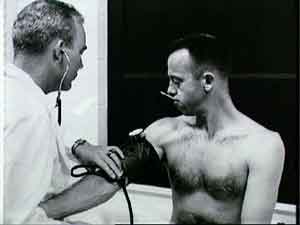






Odyssey May 2002 -- Editor: Kris Cerone

Medical Care in Microgravity
By Tina Beychok
The problem of bone mineral loss for astronauts in zero-g is well-known. Now, according to the March issue of Aerospace America, new NASA-funded research being done at SUNY Stony Brook in New York may have found an easy solution to the problem that might also have beneficial applications here on Earth.
 |
| Astronaut Alan Shepard gets a physical. NSS Space Medicine page. |
A team of biomedical engineers has come up with a concept involving use of a small, high-frequency (90 Hz) vibrating plate for astronauts to stand on while they perform their normal tasks. In early tests with lab animals and in later, Phase III trials with postmenopausal women who have experienced bone mineral loss, the plate appears to be very beneficial.
Researchers think that the subtle vibrations from the plate fool the bones into thinking that they are working hard. This can result in retention, and sometimes even additional growth, of bone tissue.
This vibrating plate can be particularly beneficial on long-duration space missions of four to six months, during which astronauts may lose up to 1.6% of bone mineral density per month. Additionally, use of the plate may also offset the time-consuming exercise programs that astronauts must currently undergo.
Tina Beychok is a medical editor and is married to OASIS president Steve Bartlett. When not working as a space activist, she teaches fencing at Renaissance Fairs and greatly enjoys allowing five-year-olds to poke holes in her.
Copyright © 1998-2003 Organization for the Advancement of Space Industrialization and Settlement. All Rights Reserved.